 Steve Schoner's
Steve Schoner's Steve Schoner's
Steve Schoner's
Meteorite Identification Page
Meteorite: "A mass of matter too small to be regarded as a minor planet, traveling in space as an unattached unit, traversing the atmosphere, or having landed on the earth, or some other planet, and still retaining its identity." (Dr. H. H. Nininger 1933)
Because the earth's crust is rich in iron oxides and iron minerals, meteorite identification is a daunting task for the layman, and even the professional geologist. For over twenty years the American Meteorite Survey has endeavored to find, catalog and distribute meteorites to institutions and collectors. We invite the submission of suspected meteorite samples for identification and appraisal. But in this task very few samples submitted turn out to be meteoric. The average is about one in a thousand. The purpose of this page is to present information that will better aid the reader to recognize meteorites.
SO you think that you may have found a meteorite?
But how can you be sure?
Does your suspected space rock fit the following criteria?
1) Is it heavy as compared to most rocks?
Meteorites have a high specific gravity and tend to be denser than most earth rocks. This is not only because of the types of minerals found in them, but because almost all of them have varying amounts of malleable iron-nickel grains. This amount ranges from a few percent to 100%. About 93% of all meteorites seen to fall are stones, and only about 5% are solid nickel-irons. The rest, less than 2% are the stony irons having an almost 50-50 mixture of stone and malleable iron-nickel. To see the metal or metal grains within a meteorite you must grind a small window on the specimen. Often metal grains appear on broken surfaces of stone meteorites as rust spots, especially if it is weathered. And if the object in question is solid iron-nickel then it will look exactly like a rusty lump or chunk of steel that is silvery inside. Because iron meteorites are comprised almost entirely of malleable metal, when struck with a hammer they will dent or bend rather than break. On the other hand, stone meteorites will pulverize, and within the brittle stony matrix are malleable metal grains that flatten rather than crush. Because malleable iron-nickel is extremely rare on earth, but common in most meteorites, it is one of the distinguishing characteristics in determining whether the rock in question is meteoric or not.

Campos Sales, Brazil; L-5, (stone), Fell Jan 31, 1991. This 96 gram full slice is from a stone that was picked up shortly after a bright meteor was sighted. Notice the white malleable metal grains in this expertly cut specimen.

Lamont, Kansas; Mesosiderite, (stony-iron) 70.6 grams. Notice the numerous iron-nickel inclusions scattered throughout a stony matrix in a nearly 50-50 mix.

Canyon Diablo, Arizona, ("Meteor Crater") iron meteorite, 245 g. In this specimen cut lengthwise the solid malleable metal interior is revealed.
2 ) Is it rusty brown, or black?
Most meteorites are rusty brown if they have been on the ground for an appreciable amount of time. This occurs because iron and iron grains in them rust with exposure to the earth's environment, and will coat the rock with a layer of oxides. On stone meteorites this will look like a dark brown varnish and with solid iron-nickel meteorites this is often a thick crust that flakes away.
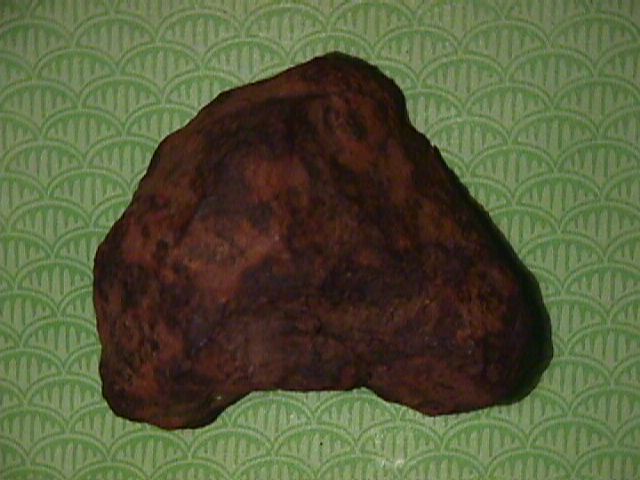
Toluca, Mexico, iron meteorite, 658 grams. This meteorite has a thick oxide coating that flakes away. Inside it is solid metal.

Macy, NM; L-6 (weathered stone), 368 grams. Notice the tan-brown surface with dark brown patches of fusion crust.
3 ) Does it have a rusty brown, to black fusion crust?
When meteorites are relatively fresh they often have a thin black crust of melted rock, or with iron meteorites a bluish black crust. This crust is usually very thin, only a few millimeters in thickness, but it is distinct enough to aid in identification. Unless very weathered, almost all meteorites will have traces of fusion crust, which is distinctly different from the interior matrix.
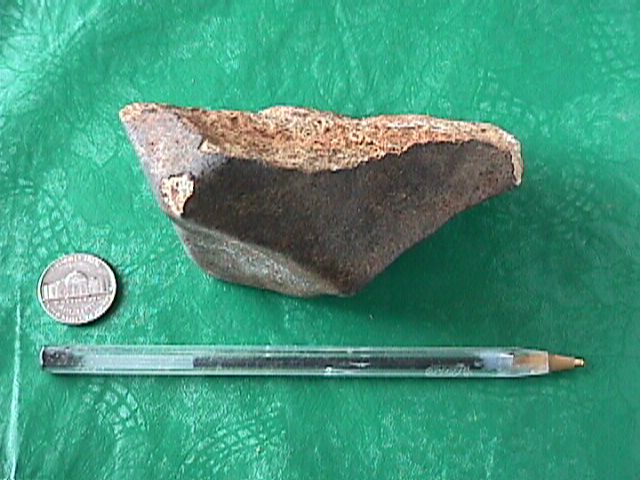
Campos Sales, L-5 (stone), 571 grams. Notice the dark smooth fusion crust, and lighter chalky interior matrix that is speckled with rust spots.
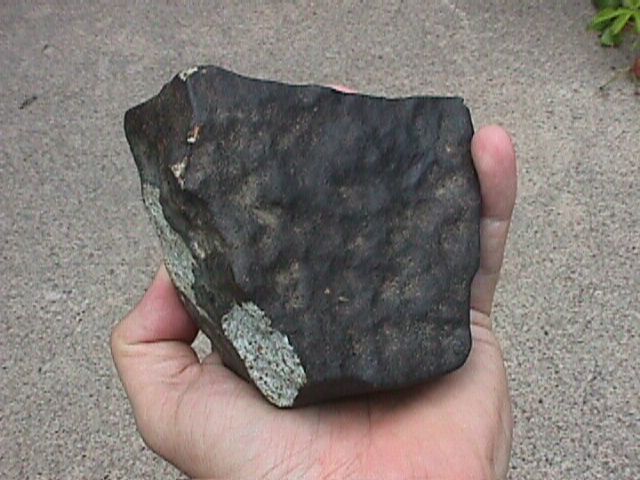
Campos Sales, Brazil, L-5, (stone) 960 grams. Notice the exceptional black fusion crust and thumbprints on this very fine specimen. The light patches are where the fusion crust was broken on impact, thus revealing this meteorite's light gray chalky stone interior. The broken surfaces are speckled with rust spots where atmospheric moisture has caused the malleable iron grains to discolor an otherwise mostly light gray matrix. This specimen was picked up very shortly after falling to earth on Jan. 31st, 1991 and is typical of most freshly fallen meteorites.
4 ) Is it solid, and lacking bubble holes?
Meteorites very rarely ever have bubble holes (vesicles or vugs). But there are a few exceptions, and one of these if it had not been an observed fall would have been discounted as a meteorite. So, if the rock has large holes all over it, and also inside a broken surface, then the chances of it being a meteorite are very, very remote.
5 ) Does the exterior of the stone look smooth, or have rounded edges? Does it have what look like shallow "thumbprints" ?
These are characteristic features of most freshly fallen meteorites, as well as many finds that were not witnessed to fall. During the hypersonic phase of the meteoroid's passage through the atmosphere as a meteor, surface temperatures are so extreme that the rock vaporizes. This vaporization is so violent and quick that very little if any heat travels into the interior of the stone, or iron before it is vaporized away. In other words, the meteoroid is vaporizing faster than heat can conduct into it. This is similar to effect to thrusting a chunk of ice into and out of a blast furnace. If the block of ice is large enough a piece of ice will survive. Likewise, the rock or iron that survives the fiery passage through the earth's atmosphere often arrives on the ground at a temperature very close to what it was when it was in space. And this is usually ice cold, but often slightly warm to the touch, especially if it fell during the daytime.
Contrary to popular belief, most meteorites do not arrive onto the surface of the earth burning. The burning fireball phase (bolide) usually terminates 15 to 20 miles above the earth, and the rock simply falls to the ground just as a solid object would if dropped from a high altitude. Compared to the spectacular celestial display meteoroids cause as their cosmic velocity is slowed during the bolide phase, the actual arrival of a meteorite on the ground is usually accompanied by nothing more than a thud and a small impact pit.
Fortunately, our planet's atmosphere slows most meteoroids down enough so that true crater forming events are rare. But for freshly fallen meteorites the surfaces of such often display a texture that is clear evidence of a fiery passage through the atmosphere. Edges are somewhat rounded, and any broad surfaces often have peculiar markings called "thumbprints" (as if the rock were plastic and someone picked it up).
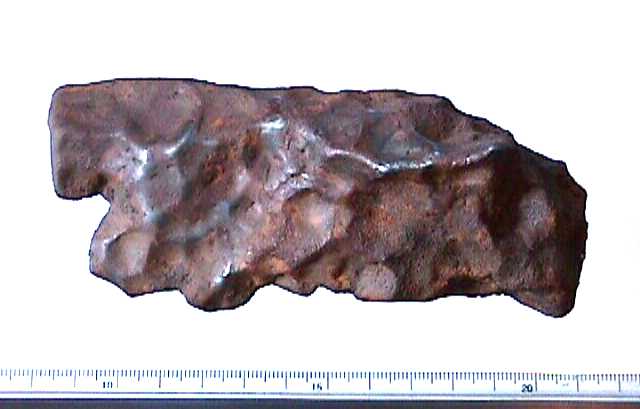
Glorieta Mountain, NM; Siderite (iron), 658 grams. Notice the "thumbprints" on this exceptionally beautiful specimen. Also present are traces of blue-black fusion crust. A space rock like this is too nice to cut or grind. But inside it looks like steel.
6 ) Is the rock magnetic and when a magnet is suspended on a string and brought near to it, is it attracted?
Nearly all meteorites have iron-nickel and some are completely iron-nickel. Except for the very rare iron free meteorites, almost all meteorites will mutually be attracted to, or by a magnet. But not all magnets are like, as today's "supermagnets" will attract almost any rock that has even a small amount of iron minerals. Iron is one of the most common terrestrial elements. Therefore in testing rocks that are suspected to be meteoric, it is suggested that a standard iron magnet as opposed to a "rare earth" magnet be used. A positive magnetic result alone does not indicate a meteorite, but when correlated with other critera narrows the possibility of the sample being or not being a meteorite.
7 ) Did you actually see the rock hit the ground?
Often I receive rocks that the finder swears they saw strike the ground. The finders are adamant that the fireball plunged to the ground.
"I saw a meteor flaming all the way to the ground last night and when I went out to look for it, I found this in the spot where it hit" they often say.
A fireball (bolide) was observed, but if anyone saw it burning all the way to the ground (horizon) it was actually many, many hundreds of miles away. The terminus of such events occurs between 15 to 20 miles above the earth, and at that point the "burning" phase often ends with huge explosion, or simply fades out. But if it hit burning all the way to the ground an explosion akin to that of an atomic bomb would surely be the result. The amount of kinetic energy in meteoroid traveling at 7 to 30 or more miles per second is enormous, and fortunately our planet's thick blanket of air protects its surface (and us) from constant bombardment. If this were not so then even a small pea sized rock or chunk of iron hitting the ground at 30 miles per second would explode with the force of a 500 lb bomb and create a crater yards in diameter. Our world would look like the moon if it were not for our atmosphere burning these cosmic interlopers up.
But such events do occur.
For if a large enough object enters the atmosphere, and then reaches the ground with even a fraction of its cosmic velocity, cratering can be extensive. The Sikhote Alin event in the former USSR on Feb 12, 1947 was the last such recorded cratering event.
Fortunately, crater forming events are rare in terms of the scale of human history, and most meteorites that fall to earth simply plunge to the earth's surface innocuously. Freshly fallen specimens are usually found beneath the track of observed fireballs, or directly under the point over the ground where the fireball terminated.
Freshly fallen meteorites, whether small or large will show (unless fragmented) some amount of fusion crust. This crust is usually dark gray to black, but in some instances such as in the rare Cumberland Falls Meteorite, Norton County Meteorite, and the Pena Blanca Springs Meteorite (observed falls) fusion crust can look like a thin tan to dark brown varnish.
Fusion crust is one of the primary characteristics that one looks for in the process of meteorite identification. Except for very weathered specimens most will have a fusion crust or traces of it, and learning to identify it is important in sorting out meteorites from "meteorwrongs"
Often after a fireball event people are excited enough to go out and look for meteorites, and previously fallen ones not related to the event that sparked one to search are sometimes found. Thus it pays to search after a major fireball sighting.
So, if your rock meets most if not all of these meteorite identification points, then there is a fair chance that it is genuine. You should then send at least a grape to walnut sized piece of it (20 - 30 grams) to a university that specializes in meteorites or to an authority, such as myself.
I have over the years received thousands of samples and ten times that number in the form of photographs. Though a photo can help me to sort out the obvious "meteorwrongs," a hard sample is the best way for me to determine if the specimen from which it came is a meteorite. In the more than 35 years that I have been involved with meteorites not once has any of my identifications been reversed by an institution, or the Meteoritical Society. But my word is only the beginning in the process, for should I deem the sample a meteorite, then classification ensues. This requires sending the sample to a university specializing in the study of meteorites and involves the use of very costly and specialized petrologic equipment and labor, which can take weeks to years. Then, and only after the results of the analysis are recorded for the scientific community will the meteorite from which the sample came be officially announced by the Meteoritical Society to be listed in the Catalog of Meteorites, an international publication of the Meteoritical Society.
I offer meteorite identification services at no cost, other than a small sample. Should your rock prove to be a meteorite, then I will evaluate it, initiate the process of its classification, and give you an idea as to what it is worth.
However, should you submit a sample, include with it a clearly written e-mail address or a STAMPED SELF ADDRESSED ENVELOPE so that I can return a reply. Without a SASE I will not return a reply. And PLEASE, DO NOT SEND ANY ROCK SAMPLES REGISTERED OR CERTIFIED ! I will not receive these, and they will be sent back unopened.
Due to the huge amount of
time that all the submissions I receive require, I no longer return
samples. Unless, proven to be meteoric, all samples will be discarded
upon my examination. Also, should you send e-mail photo attachments of
your specimen please insure that the files are in JPEG format and no
larger than 75K in size.
Steve Schoner
American Meteorite Survey /
Petroslides
5 North Bonito Street
Flagstaff, AZ 86001
e-mail:
s_schoner@msn.com
METEORITE PICTURE GALLERY
STONES
ABEE, Canada, (EH
anomalous impact melt breccia) Fell: June 9th,
1952 and found five days later.
The Abee Meteorite is one of the strangest meteorites known.
Enigmatic, it is the subject of intense study. Unlike most meteorites,
Abee is host to very odd minerals where oxygen is lacking and sulfur
fills its place. Freshly cut pieces of this meteorite have a distinct
gunpowder odor which is due to the high sulfur content. Also, what is
visually striking is its odd brecciated internal structure where the
clasts are rimmed with a metal rind. No other meteorite has this
structure, and it is unique.
Theories as to how and where the Abee Meteorite originated abound, but one of the most interesting is that it may have formed in the vicinity of Mercury, and may even have clasts ejected from that planet in the violent impacts that created it. Yet to be explained is how it assumed an orbit that intersected with that of the Earth. The mechanics of how this occurred is not known, but the minerals and chemistry of this rock are what researchers would expect to find on Mercury.
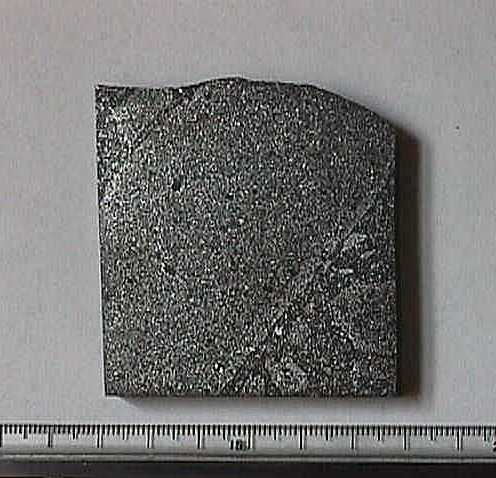
111 gram part slice of the Abee Meteorite clearly shows one large metal rimmed clast and many smaller ones that are characteristic of this unusual meteorite. (Scale is in cm.)
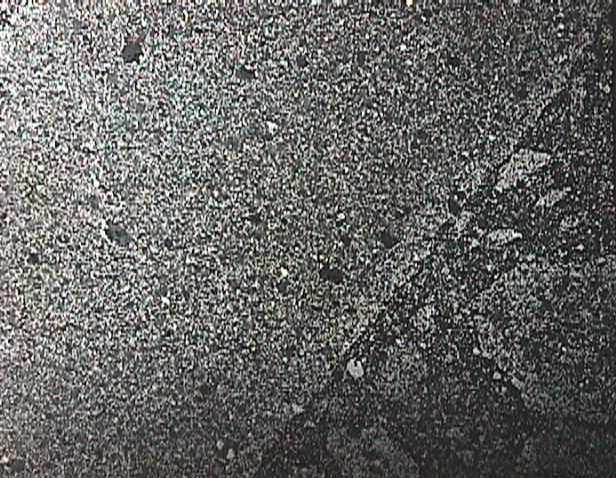
Enlargement of the brecciated structure in the Abee Meteorite. Scattered throughout this matrix are microscopic diamonds.
CORREO, NEW MEXICO, H-4. A
typical high iron common chondrite.
A very fine 46.5 gram oriented high iron stone meteorite from Correo,
NM.

This view is from the back side of the flight oriented stone. Fusion crust is readily apparent, and the lighter interior is evident in a broken area on the right and on the top. Under magnification tiny chondrules (round balls) are evident in these broken faces.
GOLD BASIN, ARIZONA, L-4 A
typical common chondrite.
This common stone meteorite (chondrite) was first recognized by gold
prospectors who had seen meteorites on display. Thus far hundreds of
pounds, in the form of thousands of specimens have been recovered. The
Gold Basin Meteorite is a typical weathered chondrite.
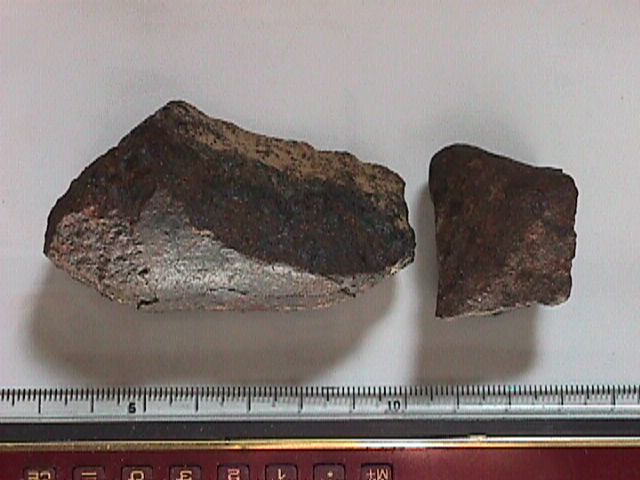
Two Gold Basin, Arizona meteorites in as found condition. The larger one on the left weighs 138 grams, and the smaller one on the right weighs in at 38 grams. Both have a dark brown oxide coating, yet even though these meteorites might have been on the ground for 20,000 years or more, both still have traces of their original fusion crust. Because these "sound off " a metal detector, they are fairly easy to find. But unless one was real keen on meteorite identification these would be easy to miss amid the myriad of rocks that form desert pavement at the Gold Basin site.
HOLBROOK, ARIZONA,
L-6, Fell: July 19, 1912
This 221 gram specimen was recovered in the summer of 1992, eighty
years after its fall
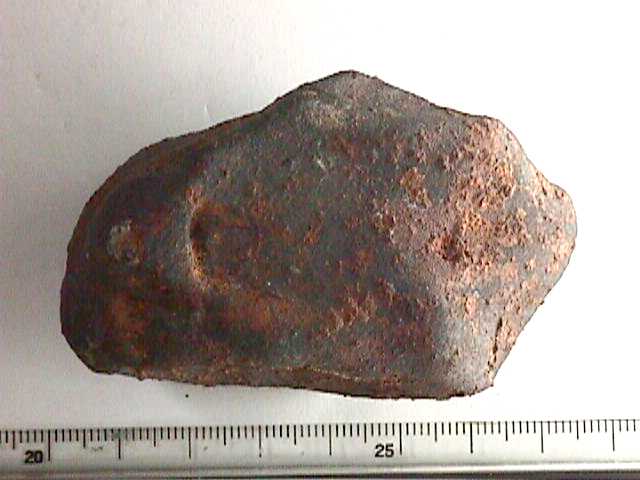
(scale is in cm)
Notice the dark almost black fusion crust covered with protruding rust spots. These spots are often found on fusion crusted stone meteorites and are quite distinct. The interior of this stone is a light gray matrix with numerous rust spots where the iron has oxidized over the eighty years that it was on the ground.
LAFAYETTE,
INDIANA, SNC; Identified
in the Purdue University collection in 1931
The Lafayette Meteorite is one of the rarest
meteorites known, and certainly originated on Mars. Composed primarily
of monoclinic pyroxine , similar to the mineral diopside, this
extremely rare meteorite of about 800 grams was found in the Purdue
University collection in 1931. For years it was in their collection
identified not as a meteorite but as a "glacial pebble." But according
to H. H. Nininger it may have been a witnessed fall, for in his
investigation of it he found that some years earlier a black student is
said to have donated it to the university saying that he saw it fall a
few yards from where he was standing. Years later, and after it had
been identified, it was thought to be related to the Nakhla Meteorite
that fell in Egypt in 1911. Speculation abounded that it might have
been a transported specimen from that fall. Later, in 1980 analysis by
J. L. Berkley, et al. revealed that it is distinct from Nakhla. The
differences reside primarily in the hydrated minerals in this unusual
meteorite. Water extracted from these hydrated minerals reflect rare
gas ratios that indicate Martian origin. In the Lafayette Meteorite
these hydrated minerals have iron oxide shells that some speculate
might be related to, and evidence of biologic activity on Mars even as
recently as 700 million years ago. (Kargil, USGS).
Martian meteorites are thought to have been blown from the surface of Mars during asteroid impacts as recently as 10 to 15 million years ago.
The main mass of the Lafayette Meteorite now resides in the Smithsonian Meteorite Collection, and the following pictures are of a .87 gram sample obtained in 1981 from the previous holder of the main mass,the Chicago Field Museum.

.87 gram fragment of the Lafayette Meteorite in its aluminum and glass retaining cell.
. 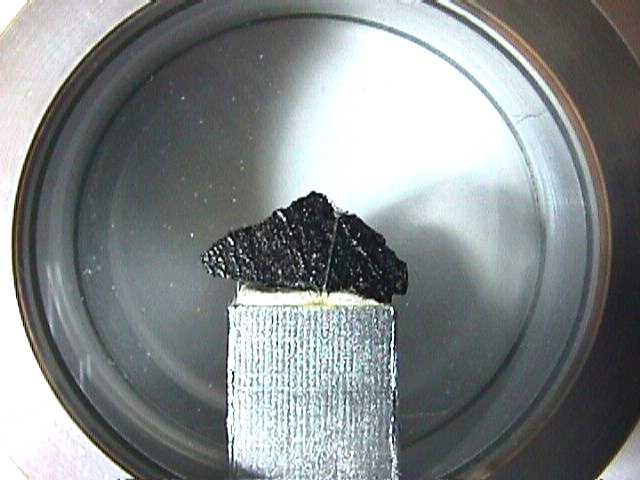
Enlargement of fusion crusted Lafayette fragment and its retaining cell.
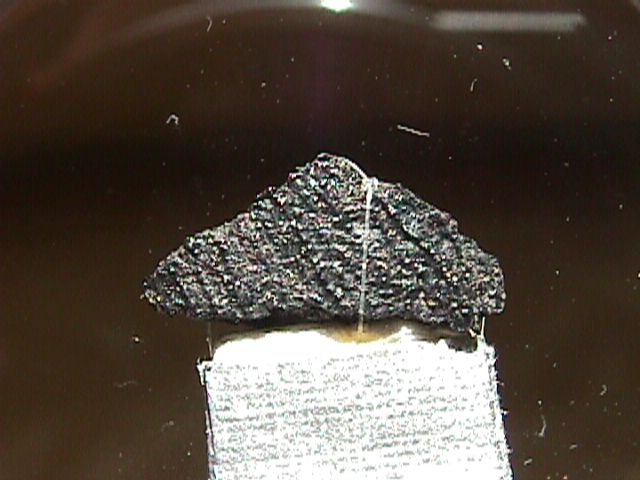
Enlargement of .87 gram fragment's fusion crusted side showing the parallel flow lines that were in fact radial lines on the original oriented main mass, considered by many to have been one of the most beautifully oriented meteorites ever found. Length of specimen is 1.2 cm.
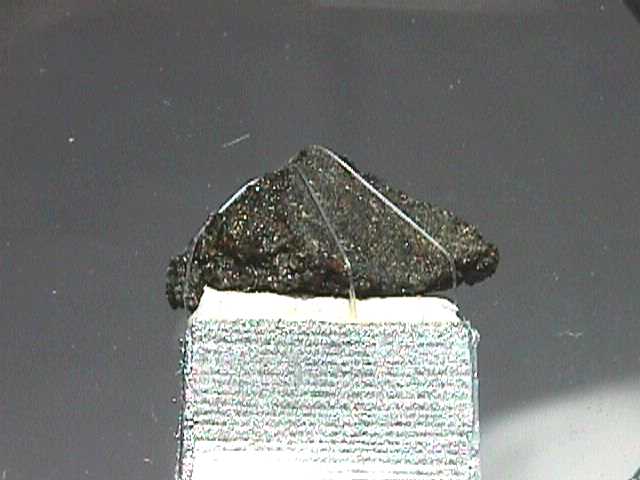
Opposite side of .87 gram specimen showing cut face and rough break. The color of this meteorite is a deep drab olive green with brown (hydrated) crystals. It has no free malleable iron, no rust spots and is not magnetic. Hydrated minerals found in this meteorite upon analysis reveal the signature of the Martian atmosphere with regards to zenon- krypton ratios. Age dated at about 1.6 billion years, the Lafayette meteorite is much younger than most meteorites, which have age dates of about 4.55 billion years. This alone is clear indication that this and the 14 other meteorites of the SNC class came from a planetary body (Mars) rather than an asteroid.
It is unlikely that this type of meteorite will be identified in the field unless observed to fall as it is so much like earth rocks. The only outward evidence of its cosmic nature is the presence of a distinct fusion crust. It was the glassy fusion crust that brought it to the Chicago Field Museum's curator's attention. There are to date in 2000 fifteen SNC (Shergotty, Nakhla, Chassigny) meteorites known, and the most recent, the paired Los Angeles 001 and 002 meteorites were initially identifed by the finder solely by the presence of fusion crust alone.
Fusion crust is the primary characteristic in identifying freshly fallen meteorites and is often the layman's only clue that indicates a cosmic origin. For this reason being able to recognize a fusion crust is very important in sorting out meteorites from "meteorwrongs."
NWA 482 Lunar Anorthositic Impact Melt Breccia
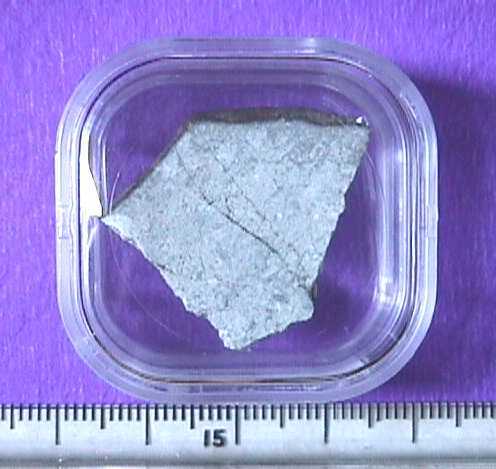
2.162 gram fusion crusted part slice of NWA482 showing thin impact melt veins and white anorthositic clasts set in an predominantly anorthositic impact melt matrix.
NWA 482 is an extremely rare meteorite. Of all the meteorites thus far recovered, over 25,000, only 15 are of lunar origin. Though none have been observed to fall it is thought that less than one tenth of one percent of all the meteorites that fall might come from the moon. The mode of transfer is by asteroid-meteoroid impact. Though the moon is close to the earth, it would seem that more should come from that body, but the fact is that the dynamics of trajectories from the moon have to be very precise if rocks ejected from the lunar surface are ever to reach the earth. If too fast, they are accelerated to velocities by the Earth's gravity well that preclude them being captured by the Earth. Instead, they are flung out of the Earth-Moon system to assume their own orbits around the Sun, where they may or may not be captured by the Earth at a later time. If the ejection velocity is too slow, then they simply fall back to the moon. If however, the speed is such that they almost stop between the Moon and the Earth, with only a few meters per/sec in the Earth's favor then the Earth's gravity effects a capture and the chances of them falling to the Earth's surface vastly increases. Passage through the Earth's atmosphere undoubtedly destroys most of them, but a small fraction of these rocks do reach the surface.
Such was the case for NWA (North West Africa) 482, found by a nomad in Morocco or Algeria and later purchased by Jim Strope and Michael Farmer in December of 2000. The stone the recovered weighed 1015 grams, was oriented, and fully fusion crusted. Until cut, and examined with the proper scientific procedures and equipment there was nothing to indicate its lunar origin. But once cut, and properly examined, the mineralogy revealed intense shock, and impact melting that are the hallmarks of lunar rocks. Numerous impactors have over the eons bombarded the moon. Its surface has been thus churned and melted by these impacts resulting in a wide variety of impact melts and regolithic rocks. Lunar meteorites and the Apollo samples tell of an intense period of meteoroid bombardment of the Moon's surface 3.9 billion years ago. They also reveal other events subsequent to that period where the Moon's as well as the Earth's surface were pounded under these cosmic collisions. Unlike the Apollo samples, the lunar meteorites come from random locations, and offer a wide variety of sample types. Thus they are invaluable adjuncts to the Apollo samples in understanding the cosmic history of our nearest neighbor in space.
Of the lunar meteorites thus far recovered, NWA is unique for several reasons. Unlike the others that are weathered, NWA 482 is extremely fresh, and compares with the pristine Apollo samples. NWA is also whitish gray and is significantly higher in the mineral anorthosite, than the others. Anorthosite is a characteristic mineral found in the lunar highlands, and represents the oldest rocks found on the moon. The "Genesis Rock" that was found on the Apollo 16 mission is a prime example of lunar highland material.
NWA 482 is comparable to this and other Apollo lunar samples and it thus the subject of intense study with many reports still pending.
STONY-IRONS
GLORIETA MOUNTAIN, New Mexico. Pallasite
The Glorieta Mountain Meteorite is an exceptionally attractive
meteorite. It is found in two forms, siderites (irons) and pallasites
(olivine and iron). The ratio of iron to olivine in the pallasitic
forms favors iron with usual compositions of 60% iron to 30% olivine.
But sometimes Glorieta irons are found with only one or two olivine
crystals showing. So the distribution of olivine in the metal matrix is
spotty.
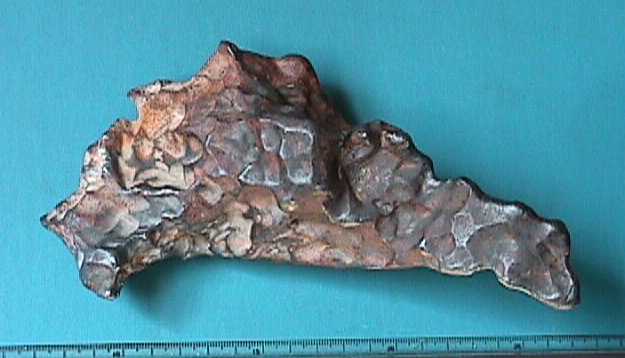
A spectacular Glorieta iron meteorite of 1,592 grams in weight with blue black fusion crust and several olivine crystals in the midst of the numerous thumbprints. Though this meteorite has been on the ground for many hundreds of years it looks like it fell "yesterday."
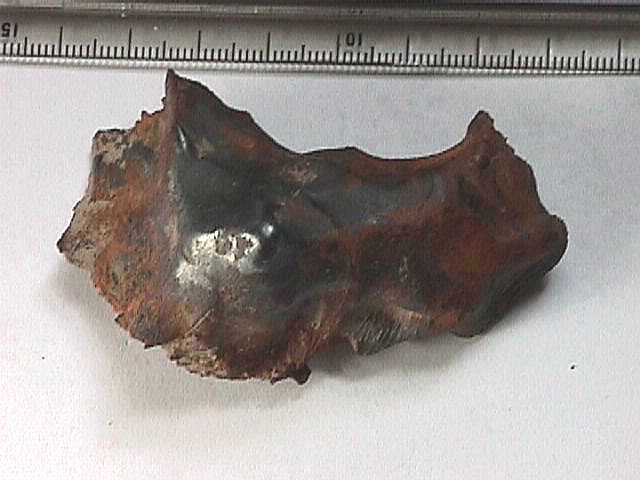
A fine 190 gram example, this one has flow lines in the blue black fusion crust on the bottom edge. Often fresh fallen meteorites will have flow lines caused by the thin coating of melted rock or iron streaming all over the specimen. But fractions of a millimeter beneath this crust. the underlying matrix remains unscathed by heat.
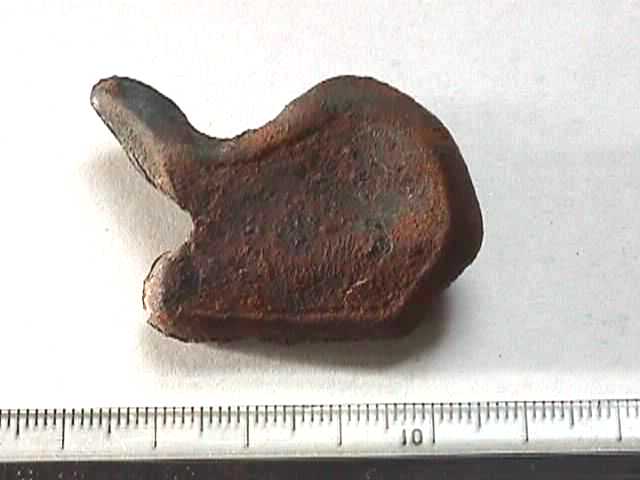
A very unusual oriented Glorieta iron of 51 grams weight, the view is from the back and clearly shows the melt build up along the outer edge of this otherwise flat specimen. On the other side, the nose, very fine flow lines radiate from the apex, which was originally a single olivine crystal blown, or burned out in flight.
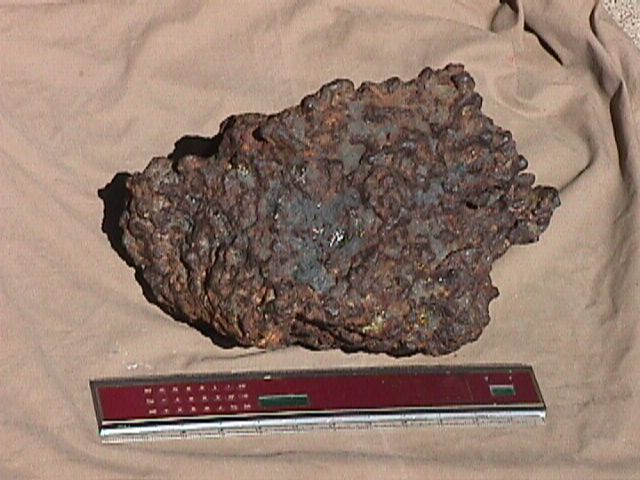
A large 20.4 kilo pallasite found in the Glorieta area. The deep recesses of this otherwise iron meteorite are chock full of olivine crystals, which appear as glassy yellow green crystals. Also present are patches of slate gray fusion crust, a clear indication that this meteorite must not have fallen too long ago.
A full slice from the above specimen showing the pallasitic structure of olivine, iron-nickel, and sulfides. Size across the longest dimension is about 8 inches. (Photo by Darryl Pitt, curator of the Macovich Collection)
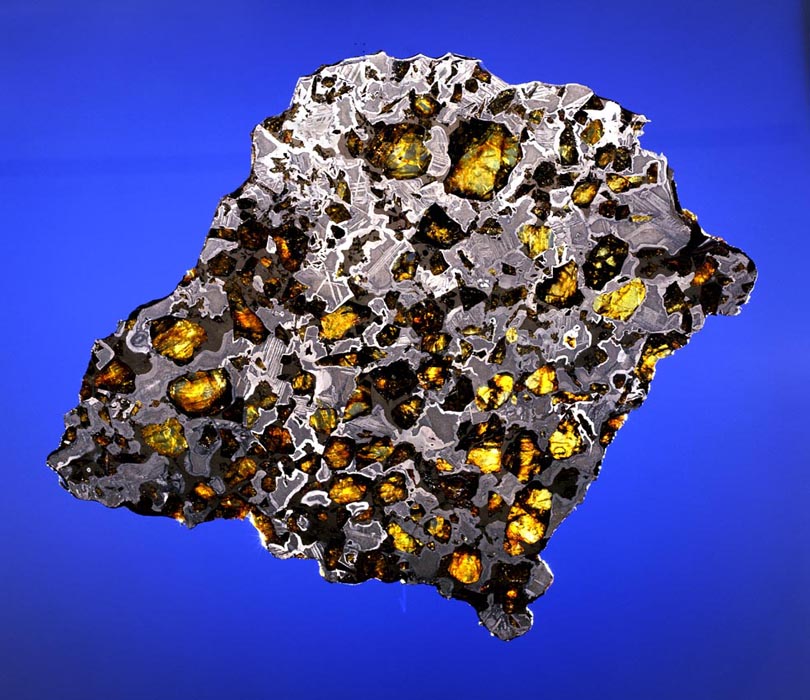
LAMONT, KANSAS Mesosiderite
Mr. Haas of Lamont, Kansas, found the very rare Lamont Meteorite
over fifty years ago. In 1996 he submitted a fragment to the American
Meteorite Survey and it was identified as a mesosiderite. It is unusual
in that it has a higher amount of olivine than most other meteorites of
its class. Unfortunately, after cutting it rusts and most samples of it
must be kept in airtight containers to prevent further rusting.
The 900 gram endpiece shown here is, however, exempt from this condition, and is from the only portion of the main mass that was rust free. Portions of this meteorite reside in private collections, the Smithsonian Institution, The Chicago Field Museum, and UCLA.
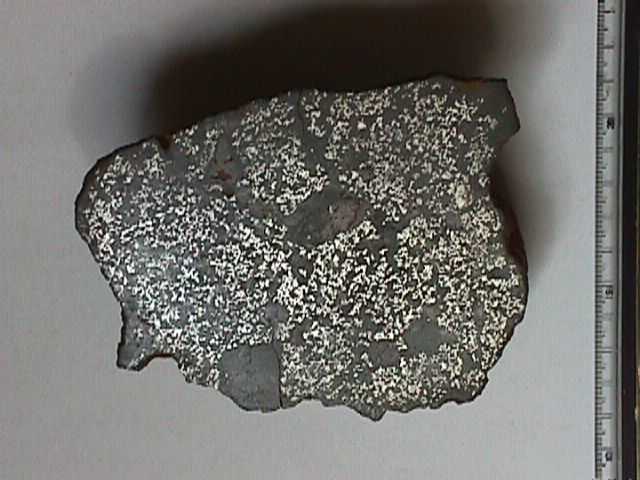
This 900 gram Lamont endpiece shows numerous metal flecks scattered throughout its brecciated stony matrix. Mesosiderites are composed of diverse mineral assemblages that indicate a violent cosmic history. This and other meteorites like it probably resided in asteroids that were repeatedly involved in collisions with other asteroids at the early stages of our Solar System's formation.
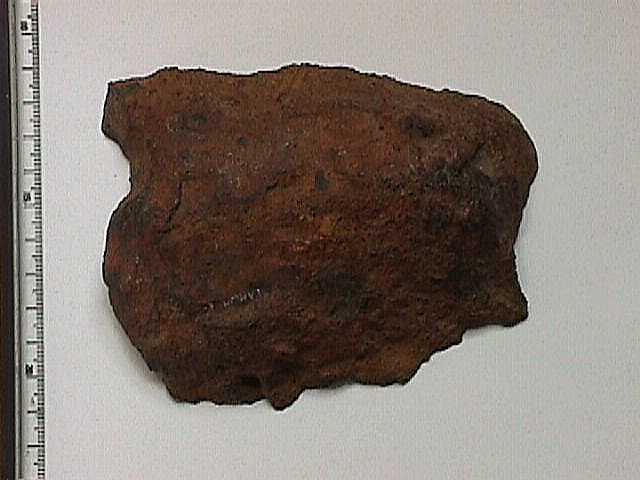
Opposite side of the 900 gram Lamont endpiece shows its rusty brown exterior. There is nothing on the outside of this meteorite that hints at the extraordinary structures that it contains.
QUIJINGUE, BRAZIL. PALLASITE.
Found 1964, Identified in 1998.
The Quijingue, Brazil meteorite is a fine example of the Pallasite
class of meteorites. It is characterized by having large golden yellow
green rounded olivine crystals encased in an silver iron-nickel matrix.
Of all the known meteorites, pallasites are the most beautiful, and yet
the least understood. Because of the nature of olivine, these
meteorites do not yield their secrets to scientists easily, and though
they are the objects of intense study, and theories as to their origins
abound, the cosmic code that they contain has not yet been cracked.

A 58 gram cut block of the Quijingue Meteorite. The overall ratio of the mineral olivine to that of iron is 70% olivine to 30% iron.
IRONS
CANYON DIABLO, (Meteor Crater)
ARIZONA. Iron.
This is a typical "Meteor Crater" meteorite and they are very prized
additions to any serious meteorite collection. At, and before the turn
of the last century many thousands of these irons were found scattered
on the surface of the ground and plains around what we now know is a
meteorite crater, one of the best preserved on earth. Subsequent
collection activity, (legal, and illegal) have removed all of the
surface meteorites, so that now they can be found only with a metal
detector and often very deeply buried. Such collection activity is
prohibited.
.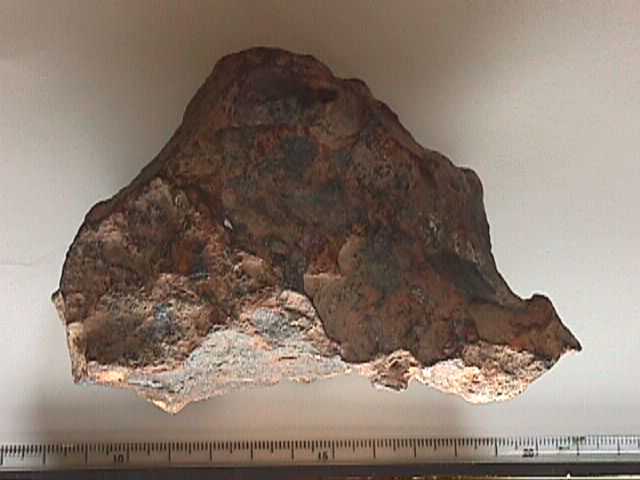
A very fine Canyon Diablo iron of 5.75 lbs in weight that is in "as found" condition. Often such irons are wire brushed giving them an un-natural appearance. But this one was found on the surface of the ground many years ago, and kept in its natural condition.
BRENHAM, KANSAS. (a rare iron example)
Brenham meteorites are usually pallasites. Pallasites are extremely
beautiful meteorites characterized by having varying amounts of
iron-nickel, and olivine. Upon cutting the mix of silver and lovely
green olivine crystals are awesome to behold. However, there are rare
examples of solid irons coming from sites that normally have
pallasites.
The following pictures are of a solid iron Brenham meteorite weighing about 11.5 lbs that was found by Mr. Ross of Brenham, KS in 1985. It was purchased by the American Meteorite Survey the following year and later sectioned into two halves. One resides in the UCLA meteorite collection and the other half, the one pictured, is retained by the American Meteorite Survey.

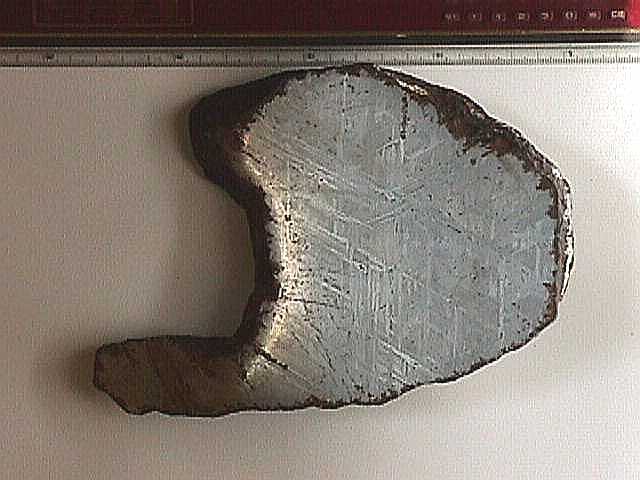
View of the Brenham iron's cut face. Notice the beautiful Widmanstatten pattern that is typical of most iron meteorites. This pattern varies from very fine to very coarse, and is often used to determine the octahedral type of iron meteorite.
And...
Dr. Harvey Nininger,
John Streng, and me....
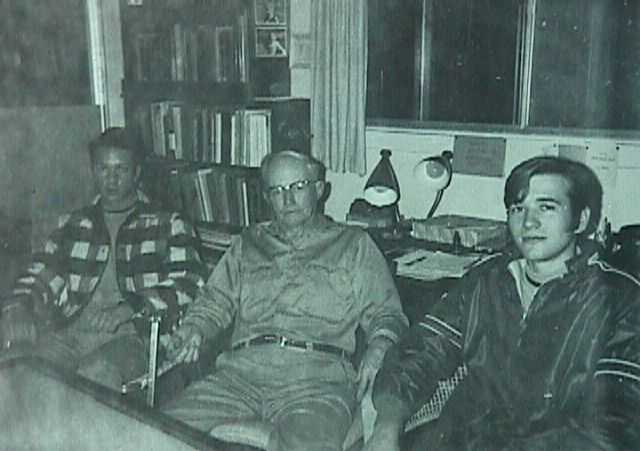
My late friend and mentor, Dr Harvey Nininger at his home in Sedona; February of 1970. From left to right, wearing a checkered jacket, is my life long friend John Streng. In the center is Dr. Nininger, and then a much younger me. Dr. Nininger was one of the finest men that I have ever known. His enthusiasm for meteorites and his wonderful speaking ability have been an inspiration to me to this day. At the time of this photograph Dr. Nininger was 83, but still in fantastic physical condition. When we arrived earlier that day he was out in his back yard with a pick trenching a foundation for a stone wall that he was building. I had corresponded with him about meteorites previously, and I had met him many times at La Verne College not too far from my home town of Pomona, California where he gave many lectures on meteorites, and his experiences finding them. I often quizzed him about some arcane aspect of meteorites, and he jokingly called me "Dr. Schoner."
If you would like to learn
more about meteorites and the people that find them, Richard Norton's
"Rocks from Space" is an excellent read.
I buy, and sell meteorites. If you wish to sell, or to purchase a meteorite, go to: AMERICAN METEORITE SURVEY Est. 1979 and Now PETROSLIDES
If your find is genuine, I will make a fair offer on it for an outright purchase, or I can list it at a very modest sales commission and obtain the best price for you.
LASTLY, WORDS OF CAUTION... In buying meteorites the rule is KNOW THE SOURCE! There are many things being touted at various sites and auction sites as meteorites when in fact they are not. This is especially so with regards to the extremely rare lunar and martian meteorites. Though the more common meteorite types are fairly easy to recognize for anyone with a degree of expertise, this is not so with regards to lunar and martian meteorites. These often command many hundreds to thousands of dollars per/gram and thus represent a very considerable investment. Therefore it is important to know the source, and the integrity of the person selling such specimens. It is strongly advised that one not purchase any supposed lunar or martian meteorites unless the mass from which the sample came is recognized as such by the Meteorititical Society, an association of legitimate scientists dedicated to the study of meteorites. An official list of all of the known lunar and martian meteorites can be found in their Meteorite Bulletin... and if it does not appear there, then it is most likely not what the seller claims it to be. For more information on the Meteoritical Society and to view the latest and official Meteorite Bulletin click the following link:
Copyright S. R. Schoner 2000